|
Fort Clatsop
Administrative History |

|
CHAPTER EIGHT:
INTERPRETATION
Over the last thirty-five years, the staff at Fort Clatsop has developed a nationally recognized interpretive program, designed to present to the public the story of the Lewis and Clark Expedition and its stay at Fort Clatsop during the winter of 1805-1806. The 1958 Suggested Historical Area Report described a potential memorial where the site of the replicated fort structure, in combination with the restoration of the historically documented coastal forest environment of 1805-1806, could offer the visitor a physical setting in which to imagine the Expedition party. Since the opening of the visitor center in 1963, the memorial's interpretation has evolved into a comprehensive presentation of the Expedition, its encounters and effects at the turn of the 19th century.
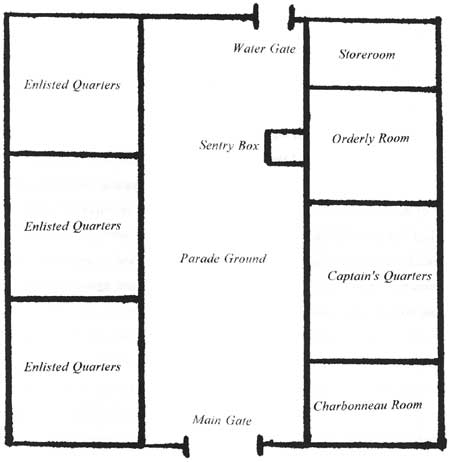
|
| Floorplan, Fort Clatsop replica. |
The memorial began telling the story of the Expedition through exhibits and other media utilized at the visitor center and the fort replica. From 1963 to the present, the memorial has broadened the scope of its interpretation through: the development of costumed demonstration programs, held throughout spring and summer and on special occasions; increased seasonal staffing; utilization of the memorial's growing reference library collection; an expanded collection of educational films and videos; expanded and improved exhibit displays, temporary displays, including artifacts from the Lewis and Clark Expedition on loan from other institutions; the filming of costumed demonstrations on laser disc format, shown in the visitor center; and the development of a variety of educational school programs, held both on and off site. Memorial staff have broadened both the depth and reach of its interpretive programs.
Interpretation, 1955-1963
After the replica was finished and the Sesquicentennial over, OHS installed a chain link fence around the structure for security. OHS could not afford to hire anyone to be at the site year-round for its protection and interpretation and the society was already in the midst of trying to get Fort Clatsop transferred into federal ownership. For those reasons, OHS interpretation was limited. Burnby Bell, secretary of the Clatsop County Historical Society, handled all replica business for OHS. During the summers of 1956-1958, while the outcome of the legislative movement was pending, the society was able to hire someone to open the site during the day and be on-site for protection and maintenance. This person was responsible for opening the replica, maintaining the pit toilets, answering questions for visitors, handling a donation box, and selling small, miscellaneous souvenirs for the Clatsop County Historical Society.
From 1959 until 1963, while regional and memorial staff were absorbed in the various developments necessary to make Fort Clatsop a functioning unit of the NPS, actual interpretation remained limited. During 1961, the memorial hired a seasonal to be at the fort replica eight hours a day from July 13-September 9. From September to November, the seasonal was at the replica on the weekends. During the remainder of the winter, the replica remained locked. Available at the memorial was a brochure designed by the Astoria Chamber of Commerce that described Fort Clatsop and the Astoria Column.
Planning for the memorial's interpretive programs began with the site concept for the memorial and continued with the development of the memorial's visitor center exhibits and the rehabilitation of the fort replica. Planning also included researching and acquiring interpretive materials such as films, books for the memorial's library, and materials for the visitor center exhibits. The staff consisted of two employees until 1962, and in 1963 increased to four employees with one seasonal. For the first years under NPS management, the small staff was consumed with planning duties and construction.
A draft interpretive prospectus was completed by Park Historian Burnby Bell in 1961. In the prospectus, Bell stated that three methods would be used to present the story of the Lewis and Clark Expedition to the public. These were: visitor center exhibits, the reconstructed and furnished replica, and the area itself, which would have self-guiding trails and interpretive signs. Bell outlined twelve possible exhibit cases for the visitor center, which would include information about the geopolitical climate of the Expedition, the preparation and beginning of the Expedition, major events which occurred as the Expedition crossed the continent, time spent at Fort Clatsop, and the American Indian communities encountered along the route and on the Pacific Coast. Bell also called for a display of dugout canoes at the canoe landing site, with interpretive signs. While most of the ideas in the 1961 draft prospectus for the visitor center were used, the master plan and the historic structures report determined that the replica would be furnished only with the crude furnishings which would have been left behind by the Expedition. The display of dugout canoes at the canoe landing and the placement of wayside exhibit signs were not realized until after 1970.
Interpretation, 1963-1970
When the memorial visitor center was completed and opened to the public in 1963, interpretation was structured to educate the visitor about the Lewis and Clark Expedition and its contributions to the development of the nation. During the summer, one or two seasonals were hired to be at the replica to answer visitors' questions about the replica and the Expedition. Because the staff was small, and often not available at the fort, visitor activated audio messages were installed to provide the visitor with a short narrative about the fort and the Expedition's stay during the winter of 1806. All the staff, including the superintendent, spent time at the front desk greeting visitors, answering questions, selling souvenirs from the FCHA sales counter, tallying the number of visitors, and handing out park brochures. Visitation exceeded the numbers expected. School groups visited the memorial regularly on field trips, the numbers doubling from 1963 to 1964 alone. [1]
The visitor center exhibit was designed to treat the entire Expedition, from Jefferson's instructions to the Expedition's end and its consequences. The centerpiece of the exhibit was a wall map, displaying the Expedition's route from Camp Wood, where the Expedition prepared for the trek across the continent, to the Pacific. Sites of important events, points of decision-making, the scientific and geographical information collected along the way, supply and equipment caches, and encounters with American Indian communities were marked along the map. Other exhibits included a discussion of the goals of the Expedition, the construction of Fort Clatsop, the daily routine of life at Fort Clatsop, and the fate of the members after the Expedition. During the development of the visitor center, the memorial was loaned a Northwest Coast style canoe for display as the centerpiece for presenting the Clatsop and Chinook people with whom the Expedition spent the winter. [2] The exhibit also included a diorama depicting the beached whale at Cannon Beach (to which Expedition members travelled in an attempt to procure some of the animal's flesh and oil) and a picture depicting the salt makers' camp at Seaside. Artifacts for the museum exhibit included antique woodworking tools, beaver pelts, sea otter pelt, Northwest American Indian baskets, trade beads and a calumet pipe bowl and stem. While park staff had input into planning the exhibits, the actual exhibits were designed and constructed by NPS exhibit designers at the Western Museum Laboratory in San Francisco, California.
The memorial purchased films about the Expedition, like Encyclopedia Britannica's "The Journals of Lewis and Clark." These films were shown several times daily at the visitor center and also taken to off-site locations, such as Fort Stevens, and shown as part of the fort's outreach programs. Other historical films about western history and American history were purchased over the years. The memorial established a successful film loan program, which is a major portion of its educational outreach programs today. Educational films and videos are loaned to local and regional schools and groups. A slide program, completed and implemented in 1965, was also shown on a regular daily schedule. Created by NPS audio-visual designers, the show consisted of pictures from along the Expedition route and included a taped narration.
During this time period, remodeling projects at the replica continued. According to the memorial's "Historic Structures Report and Furnishings Plan," the replica was to look as though the Expedition members just left, supplying only the idea of their shelter and their furnishings. In 1968, the memorial's revegetation program continued with the planting of trees to screen the replica from the parking lot. The seclusion of the replica from the memorial's modern buildings was desirable to foster an atmosphere similar to that experienced by the Expedition members.
From 1963 to 1970, special interpretive programs celebrated the opening of the visitor center, the 450,000th visitor to the memorial, and the 50th anniversary of the NPS. The memorial also hosted the Oregon Lewis and Clark Trail Commission.
During the 1960s, living history programs and black powder weapons demonstrations gained popularity throughout the National Park Service, especially in the eastern historical sites and battlefields of the American Revolution and Civil War. Living history programs were stimulated through the concept of the living farm and NPS Director George Hartzog encouraged the development of such programs. In 1968, 41 areas reported living history programs and by 1974 the number was 114. [3] In 1968, Fort Clatsop Park Ranger Emmet Nichols began black powder flintlock rifle demonstrations at Fort Clatsop. This demonstration of the weapons and skills of the Expedition would become the key element of the memorial's costumed demonstration programs.
Development Of Interpretive Programs, 1970 to 1985
In 1970, Superintendent Paul Haertel and Chief Ranger Al Stonestreet placed emphasis on the development of the memorial's "living history" programs. Memorial staff researched other topics for presentation. Seasonals were allowed to research aspects of the Expedition of interest to them and to develop their own programs. They were to develop talks that were thoroughly researched and presented in appropriate format for park visitors. The growing library collection at the memorial, stocked mostly through the donation of books by the FCHA, and trips to conferences and workshops about the Expedition or about 1805-1806 era frontier life and skills, provided a knowledge base for these programs. Members of the Lewis and Clark Trail Heritage Foundation, especially Robert Lange, Dr. Eldon Chuinard, and Irving Anderson, also provided technical assistance to the memorial staff in accurately developing these programs. The theme of the "living history" demonstration programs centered around the presentation of life at Fort Clatsop during the winter of 1805-1806 and the skills employed by the Expedition to stay alive.
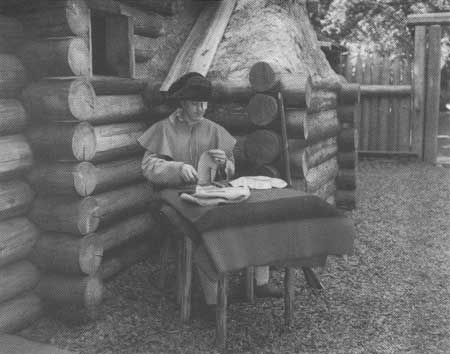
|
| Ranger Phil Jones sewing moccasins, 1970. (FOCL photo collection) |
The journals of the Expedition, of Meriwether Lewis, William Clark, Sergeants John Ordway and Patrick Gass, and Private Joseph Whitehouse, indicate the types of activities the Expedition members engaged in on a daily basis, not only at Fort Clatsop, but along the entire Expedition route. From these journal entries, the living history programs were developed. [4] Demonstrations include the basic flintlock loading and firing demonstration; sewing of clothing and moccasins; processing of game animals, including hide tanning and processing meat into jerky; making candles through an animal fat rendering process; lead bullet molding; flint and steel fire starting; and the carving of dugout canoes at the canoe landing site. Demonstration of these skills and various lectures were developed and delivered by the interpretive staff in third person presentations.
While the demonstration programs increased in number and variety, the fort replica's role and appearance also changed. The replica became the backdrop of these demonstration programs. Beginning in 1972, the interpretive staff furnished the replica with items similar to those used by the Expedition. Such items included hides, blankets, furs, barrels, journals and writing utensils, plant specimens, cooking utensils, and many other items. [5] Furnishings centered originally around the captains' room, but expanded to the Charbonneau room and the squad rooms. The meat room was opened for hanging meat strips (when game was available for such programs) and the demonstration of the Expedition's meat preservation techniques, as well as for storage of kegs, barrels, wood, rope, and other such items. The FCHA funded the purchase of interpretive items for furnishing the replica and providing materials for the demonstration programs. FCHA continues to provide funds for these materials.
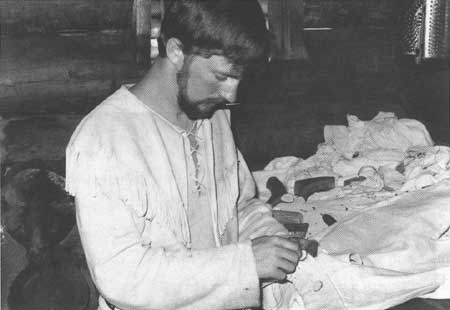 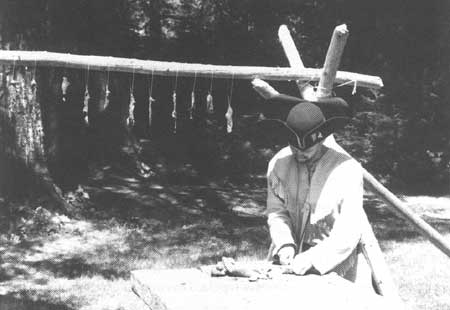
|
| Ranger Curt Ahola demonstrating sewing (above) and jerky preparation (bottom), 1971. (FOCL photo collection) |
A new Interpretive Prospectus was completed for the memorial in 1975. The study team for the new prospectus included Superintendent John Miele; James Richardson, Interpretive Management Specialist, Pacific Northwest Region; David McLean, Division of Museums, Harpers Ferry Center; Richard Krepela, Division of Audiovisual Arts, Harpers Ferry Center; and the study team captain, L. Clifford Soubier, Interpretive Planner, Division of Planning, Denver Service Center. The prospectus reviewed the interpretive programs at the memorial, identified weaknesses, and set guidelines for the future.
In its critique of memorial interpretation, the prospectus identified seven weaknesses. The auditorium was too small to accommodate summer visitation or visiting school groups, a weakness identified in 1964 by Superintendent Peterson. Second, the wall map in the visitor center exhibit was too cluttered with information and was difficult to follow. Third, wooden barriers in front of exhibit cases blocked the view of small children. Fourth, the whale diorama conveyed no significant interpretive message. Fifth, the slide program duplicated the information presented in the interpretive film, therefore providing no useful additional information. Sixth, the approach to the fort lacked any wilderness atmosphere. Finally, the fort and fort grounds were devoid of interpretive devices for when staff was not available at the replica to provide interpretive information.
To alleviate these problems, the team made five recommendations. These were: 1) develop a new audio/visual slide program, 2) make small revisions to the museum exhibit (refining the wall map to include the geopolitical implications of the Expedition and rewording American Indian exhibits to avoid stereotyping), 3) screen the trail to the fort with native vegetation, 4) design wayside exhibit signs at the fort and canoe landing, and 5) develop an environmental study area to hold school classes. The recommendations were implemented over time as funding was available.
From 1970 to 1985, the costumed demonstration programs continued to be refined. Programs such as "discovery" or "nature" walks, guided by park rangers and emphasizing natural and cultural aspects of the area and the Expedition, became a daily summer program. Other talks included the medical aspects of the Expedition, beaver trapping and the fur trade, and the local American Indian communities. In 1979, David Moffitt was added to the interpretive staff as a seasonal ranger. Moffitt's fiddling skills became the basis for the demonstration of nineteenth century fiddle music and jig dances which provided entertainment for the Expedition members. The memorial was successful in continuing this special program through the 1980s. Through the volunteer efforts of an area neighbor, a black Newfoundland dog was occasionally available at the fort to represent Lewis' dog. One program idea suggested but never developed was the development of a replica Clatsop house or village near the fort replica for further interpretation of the local American Indian community. In August 1979, the memorial's current head of interpretation, Curt Johnson, arrived at the memorial. Under Johnson, the interpretive staff have brought interpretation to its height.
Canoe carving was initiated as a popular demonstration program in 1973. From 1973 to 1975, seasonals worked on digging out a canoe at the canoe landing site, using traditional tools and fire. The first was finished in 1975. In 1977, a new cedar log was obtained and work continued on another dugout canoe. This demonstration encouraged visitors to venture to the canoe landing and join in other interpretive programs.

|
| Dugout canoe at the canoe landing site. (FOCL photo collection) |
Visitation to the memorial by local school groups continued on a regular basis. In 1979-80, a pre-site visit teacher's packet was designed to help schedule and plan field trips to the park. The packet was well received by participating school groups, which allowed them to schedule specific time and group size. On-site visitation by local schools continues to bring thousands of students, mostly fourth and fifth graders, to the memorial for educational opportunities. In 1980, the memorial began an environmental living program. This program was done in coordination with the Washington County Education Service District and provided teacher workshops, educating teachers about the memorial's environmental and problem-solving educational programs. Following the teacher workshops, seven to nine day-long student workshops would be held. These workshops provided a hands-on learning experience for the students in environmental education and problem-solving skills. This program operated on limited funding for three years.
New slide shows were developed to replace the original one, eliminating the duplication of information identified by the 1975 interpretive prospectus. In 1981, park staff developed a new slide program, called "A Wet, Disagreeable Winter," which incorporated scenes of the fort and rangers in costume. Also in 1981, two members of the Harpers Ferry Center staff, Shirley Wilt and Tom Gray, spent four days at the memorial, taking pictures of local actors in costume for the development of another new slide program. This HFC slide program, called "The Corps of Discovery," was completed in 1983 and was incorporated into interpretive programs. "The Journals of Lewis and Clark" continued to be the program's main film, showing daily and interspersed with the two new slide programs.
The native vegetation planting program became a major project during the years 1974 to 1985. The use of native vegetation and landscaping to screen the replica from the visitor center was continued. Target areas included trails between the fort, canoe landing, spring, and picnic area, as well as the open field spaces along the western edge of the county road and between the residential and utility buildings. In 1980, the trail between the fort replica and the visitor center was redirected to bring the visitor around to the fort's main gates. In combination with vegetation screening, this helped foster a separate environment from the visitor center. Also during this time period, an area was designated for black powder firing demonstrations.
Special events marked by interpretive programs during this time period included the National Parks Centennial in 1972, the memorial's one millionth visitor in 1972, the American Bicentennial in 1976, and the 175th anniversary of the Expedition in 1980. In 1974, the memorial began hosting special interpretive programs around Christmas and New Year's Day, the two holidays the Expedition spent at Fort Clatsop in 1805-06. The 1972 National Parks Centennial was marked with special events such as off-site talks by memorial staff about the NPS and its function, and an art contest at local schools. The 175th anniversary of the Expedition's stay at Fort Clatsop was marked by a significant addition to the visitor center exhibit, the "Arrival" statue.
In 1981, the Fort Clatsop Wayside Exhibit Plan was completed by the Harpers Ferry Center Wayside Exhibit branch. Written by David J. Guiney and designed by Daniel D. Feaser, the plan called for 17 wayside signs. Large exhibit signs were developed for the Fort Clatsop replica and for the Canoe Landing site, which fulfilled the recommendation in the 1975 interpretive prospectus. Fifteen other signs were developed for interpreting natural scientific information along the memorial's trails. One introduction sign and fourteen individual plant signs were placed along the trails, providing the common and scientific name, an appropriate quote from the journals (if available), and a small sketch.
Between 1970 and 1984, the interpretive staff grew considerably. In 1973, the interpretive staff consisted of five people, 2 permanent and 3 seasonal rangers. In 1984, the interpretive staff had doubled to ten people, 2 permanent and 8 seasonal rangers. By 1985, the interpretive staff grew again through the assistance of volunteers and by the Volunteers In Parks program. Many of the memorial's seasonals traditionally return for more than one season. For example, in 1983, of eight seasonal rangers, four were returning from previous seasons. [6]
During the first fifteen years of the memorial's demonstration programs, emphasis was placed on the demonstrations as "living history." In classifying the programs as "living history," only representatives of members of the Expedition were utilized in costume at the fort replica. Aside from Euro-American men, the persons of York and Sacagawea could also be represented. The memorial was active in trying to hire an African-American man and an American Indian woman to represent these two Expedition members in the memorial's demonstration programs. Over the years, a few American Indian women and two African-American men have represented these two people. [7]
The representation of York and Sacagawea was not always successful, for a couple of reasons. First, it was difficult to find people to hire as seasonals. Second, the rangers representing these two individuals had to deal with prejudice present in the general public. [8] Women rangers representing Sacagawea faced becoming a novelty, the stereotyped "squaw," and experienced a lack of authority as park rangers.
The portrayal of these two individuals as functioning members of the Expedition raises difficult historical issues regarding their relationships to the rest of the Expedition. In reality, Expedition journals state very little of substantive value regarding these two people. While representing them is a way to approach the involvement of people of different cultures in the Expedition, specifically African-American and American Indian, it also brings up the social roles of slaves and American Indian women in nineteenth century frontier culture.
Interpretation, 1985-1994
With a change in superintendents in 1985, there was a shift in the interpretive policies regarding the demonstration programs. This shift reflected a trend found throughout NPS costumed interpretation during the mid-1980s. Emphasis shifted from classification as "living history" to "costumed demonstrations." This emphasis lifted restrictive hiring practices with regards to costumed interpreters. Superintendent Frank Walker emphasized hiring the best possible interpreters, regardless of their race or gender. [9] Rather than considering or recruiting specific applicants for interpreter positions, hiring was made more equitable and was based on those applications received. Since this shift, women interpreters are given the choice of wearing men's costumes as opposed to the women's buckskin dress. For example, one woman seasonal interpreter requested wearing the men's costume for her demonstration of carpentry skills, which the dress prohibited her from doing. [10]
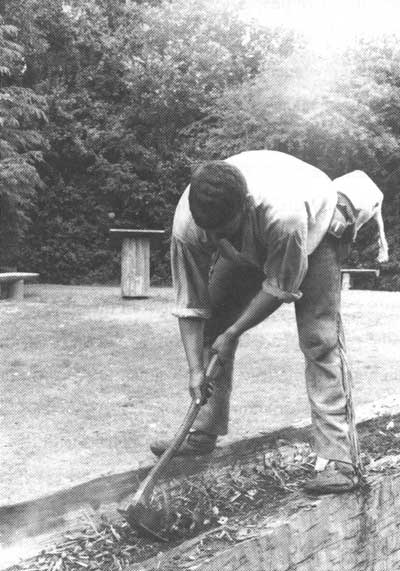
|
| Volunteer in Park Bobby Usher working on a dugout, 1989. (FOCL photo collection) |
National Park Service Directive Six (NPS-6), which covers interpretation standards throughout the Park Service, lists current definitions of living history and costumed demonstrations. Costumed demonstrations are defined as "demonstrations, animations, etc., conducted by interpreters in period dress but not utilizing first person role playing (i.e., third person presentations)." Living history is defined as demonstrations conducted by "interpreters in period clothing who are portraying a specific historical role (i.e., first person role playing). For these activities, accuracy includes not only the knowledge base, the reproduced clothing, and objects involved but also the clearly identifiable physical characteristics, identifiable after costuming, make-up, etc." NPS-6 goes on to state that care must be given in planning for living history programs that first person presentation does not result in unintentional discrimination.
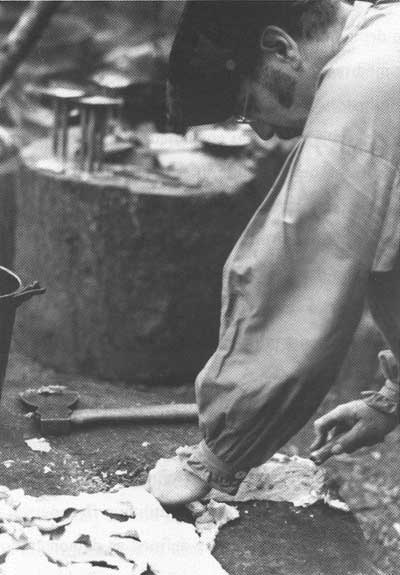
|
| Curt Johnson preparing fat for candle rendering, 1989. (FOCL photo collection) |
By these definitions, which are current, the memorial has always performed costumed demonstrations. Only occasionally have interpreters at the memorial utilized first person presentations. In such cases, the interpretive staff in charge of the development of seasonal programs were careful to know the abilities of the ranger involved in the presentation. First person presentations appeared to receive negative visitor response. [11]
First person presentation requires the visitor to believe an interpreter is someone from another time and place. If the visitor is asked to believe something and they do not, two things may happen. One, the visitor might lose interest in the program and will not remember it fondly, and two, the historical information being presented might be lost. [12 ] First person presentation is less interactive and requires acting. Third person presentation is a better learning vehicle, allowing open interaction with the audience with no pretense about who the interpreter is. An interpreter with a well-prepared and well-delivered talk is often more effective than an interpreter acting a part.
Visitors recognize that white women were not a part of the Expedition. The issue of race and gender in costume interpretation is a debate that extends to all parks presenting such programs and draws strong opinions from members of the NPS at park, regional, and national levels. Some maintain that interpretation should continue to maintain historical accuracy with regard to race or gender, even when presenting third person presentations. They consider women in men's clothing to be historically inaccurate.
The women who were the first memorial rangers to present demonstrations in costume had mixed success. Some experienced a loss of authority with some visitors that did not occur when they wore an NPS uniform. [13 ] Women interpreters currently working at the fort do not seem to experience this problem. Incidents fostered by the gender of the interpreter therefore seem to have declined over the last ten years.
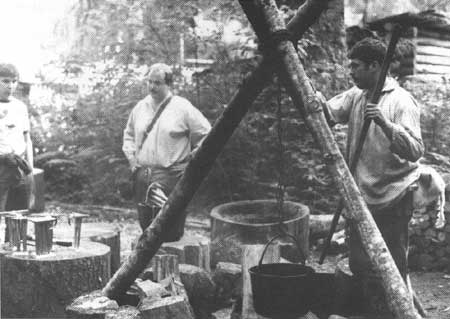
|
| Volunteer in Park Bobby Usher boiling fat for candle rendering, 1989. (FOCL photo collection) |
The material for the costumed demonstration programs between 1985 and the present center around the same fundamental programs developed since 1970. Seasonal staff are required to develop talks and demonstrations based on the interpretive themes of the park, available reference material, and their personal skills, interests, and abilities. Staff present these programs in a concise format designed to impart a specific theme to the memorial visitor. Interpretive staff rotate between replica duty in costume and visitor center duty in NPS uniform, which provides a break in their routine and helps provide variety. Interpretive themes center around the story of the Lewis and Clark Expedition and their winter encampment, the problem-solving and survival skills of the Expedition, the Clatsop and Chinook cultures' interaction with the Expedition, and environmental education and the natural environment.
Between 1985 and 1990, the memorial's interpretive brochure was translated into German, Russian, French, and Japanese. Brochures about the Volunteers In Parks program have also been updated and made available. The interpretive staff has been involved with other publications as well. Interpretive Specialist Dan Dattilio wrote Fort Clatsop: The Story Behind The Scenery, and FCHA has published The Charbonneau Family Portrait and Plant Guide to Fort Clatsop National Memorial. FCHA also published a previsit guide for educators, which was available until the visitor center expansion.
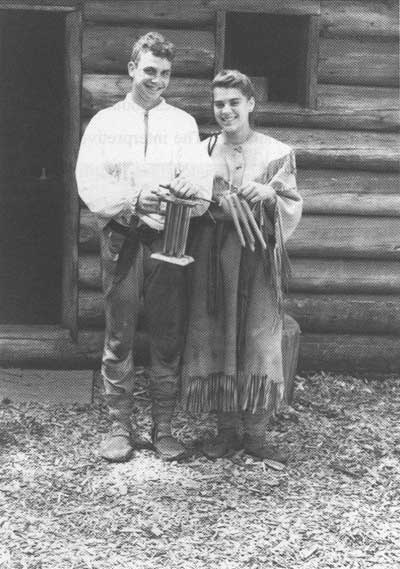
|
| Two YCC employees with the final product, 1989. (FOCL photo collection) |
In 1987, the memorial began charging a small entry fee as part of a fee enhancement funds program instituted nationwide. The fee was one dollar per person with a maximum of three dollars for a family, and was charged from April 14 to September 30. Children under thirteen and adults over 62 were free. A ten dollar annual pass was also available. In its first year, fee collection brought in $31,116. During 1994, entrance fee collection at the memorial runs from April 1 through September 30. Fees increased to two dollars per person, four dollars per family, and ten dollars for an annual pass. A variety of other special passes are also sold.
Planning began in 1989 for new visitor center exhibits, which was part of the visitor center rehabilitation project. Harpers Ferry Center Exhibit Planner Nancy Slocum, Exhibit Designer Kip Stowell, and a private exhibit contractor, Chris White, worked in conjunction with memorial staff in planning the new, enlarged exhibit hall. The exhibit theme was to stress the national and international significance of the Expedition and the events and accomplishments of its members during the Fort Clatsop winter. Five subthemes were developed: 1) the political and commercial significance of the Expedition, 2) the scientific significance, 3) the practical survival significance, 4) intercultural significance, and 5) the post-Expedition profiles of individual members. Memorial staff read draft exhibit plans, analyzed, and expressed their concern for a well-organized and flowing exhibit and coordinated their efforts with NPS planners. The final exhibit plan called for 17 exhibit cases, two of which were to be utilized for temporary exhibits. Text and materials for the remaining fifteen cases were developed to meet the five subthemes.
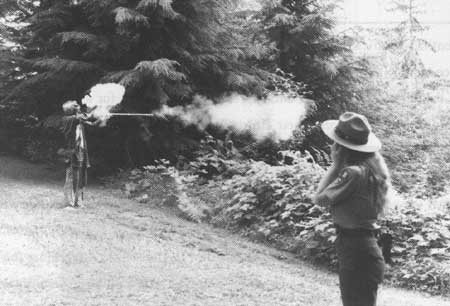
|
| Rangers Keith Watempah (demonstrating) and Sara Borok (in uniform) presenting flintlock demonstration, 1989. (FOCL photo collection) |
When the new exhibit cases arrived at the memorial from Harpers Ferry and the exhibit displays assembled, the staff were displeased with a number of things. The exhibit case framework hindered the view of materials inside, the selection of colors for materials was poor (for example, the trail route on the wall map was hard to distinguish because it was nearly the same color as the map), the carpentry work was sloppy and rough, some labels were difficult to read, certain requests made by the park staff earlier were not incorporated, and finally, the exhibit cases were not coordinated with the Denver Service Center's placement of track lighting and outlets, resulting in poor lighting on the exhibit cases. Staff from Harpers Ferry noted the memorial's concerns and traveled to Fort Clatsop to correct those problems that could be easily corrected.
However, HFC did not able to repair the most serious flaw in the cases. The framework around the cases partially blocked the view of the objects inside the case. HFC stated that they could not fix the problem with the $50,000 remaining in the project fund. The memorial requested that HFC transfer the funds to the park to complete the necessary work. HFC agreed and the memorial contracted with Interpretive Exhibits, Inc., a Salem- based company, to reface the cabinets and correct the deficiencies.
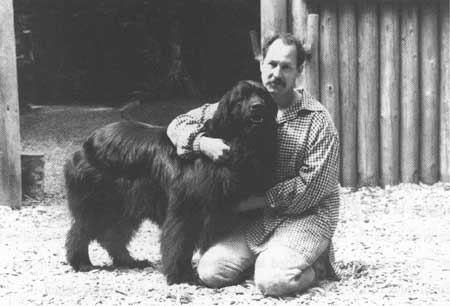
|
| Godfrey, portraying Seaman, and Ranger Bob Zimmerling. (FOCL photo collection) |
The visitor center expansion also realized the long-needed and awaited enlarged auditorium. The project also included an audio-visual booth and new equipment. In 1989, planning for a new slide program in conjunction with the expansion began. In 1990, Fort Clatsop Interpretive Specialist Scott Eckberg and Harpers Ferry Center audio-visual production officer Karine Erlebach completed the script and photographed the site for "The Farthest Reach," the memorial's current slide program. During the same project, the costumed demonstration programs were filmed and put on a laser disc format with captions. Finished in 1991, the disc system was placed in the visitor center lobby for use during periods when there are no costumed demonstrations and to provide visitors with information about activities not being demonstrated. In addition, the expansion project added a multipurpose room next to the theater, where special interpretive programs, talks, workshops, and additional audio-visual programs could be held. The multipurpose room added flexibility for the interpretive staff, especially in handling large school and tour groups.
Off Site Programs
Since Fort Clatsop began visitor services in 1963, the small memorial staff has been able to present a variety of off-site programs and lectures around the local community. These include campfire programs such as the one at Fort Stevens State Park, the first organized off-site program. Memorial staff also provided off-site programs at the area schools, service clubs, and local organizations. Topics have not only centered around the story of the Lewis and Clark Expedition, but also other topics of American history, the history of the memorial, the Park Service in general, and various environmental programs. Memorial staff have presented programs at the Astoria Children's Fair, the Clatsop County Fair, and the Lewis and Clark Historical Pageant, among other local events.
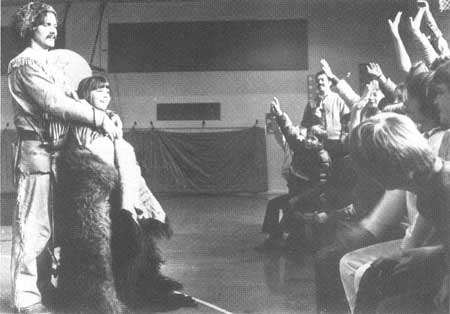
|
| Ranger Brian Huntoon presenting Ranger on the Road program at a Corvallis, Oregon school, 3 April 1981. (FOCL photo collection) |
The most successful and organized off-site educational program for the memorial has been the "Ranger on the Road" program. This program was begun in 1974 in coordination with area schools and county Education Service District (ESD) offices. The program lasted from six to fifteen weeks, depending on funding, and reached schools around the northwestern corner of Oregon and the southwestern corner of Washington. The program was designed to reach those schools that could not afford field trips to the memorial and was aimed at fourth and fifth grade levels. During the 1981 and 1982 seasons, funding restrictions began to impact the program. In order to keep the program, the county ESD offices were able to cover the costs of lodging and meals for the ranger while the memorial paid the salaries and transportation costs. FCHA assisted by covering the cost of lodging and meals and was then reimbursed by the districts. The program reached its peak in the 1979-80 seasons, lasting fifteen weeks and reaching nearly twenty thousand children. [14]
Despite its popularity and a willingness of the school districts to help fund these programs, the program was curtailed in 1983 due to memorial budget cuts. Only limited local programs could be offered as budgets, time, and available personnel allowed. In 1987, through the help of a new fee enhancement program and significant donations from FCHA, the "Ranger on the Road" program was started again. Fee enhancement funds covered transportation costs for the program and donations from FCHA, totaling $3,000 a year, covered lodging and meals. The program continued through this method of funding through 1990. Six week spring programs were held in 1987 and 1988, and a pre-site teachers packet was developed. The program reached eight weeks in 1989 for a total of 126 presentations. The program was shifted to the fall in 1990 for a six week program, October 22 - December 14, for a total of 95 presentations. The programs were again extremely successful, reaching between 3,000 and 6,000 children. Under the increased visitation levels at the memorial and the beginning of the visitor expansion project, the memorial needed the rangers at the park rather than on the road. Staffing pressures combined with budget restraints have again limited the program's reach. During 1993, the program ran from March 15 - April 19 and reached 2676 students.
Due to staffing and budget restraints, emphasis has been shifted to the creation of a travelling trunk program, which are sent to schools in the region usually reached by the ranger program. The trunks, supported by FCHA, have been extremely successful and the program was aided in 1993 by a "Parks As Classrooms" grant from the National Park Foundation. The first trunk, created in 1993, was based on the Lewis and Clark Expedition/Fort Clatsop theme. It was so successful that two identical trunks were made in 1994. The staff plans on making two or three additional trunks on other historical themes, such as a Lower Columbia American Indian trunk, to expand this program.
The interpretive staff is currently working on a formal five-year educational plan that would restructure and direct the memorial's educational services. The plan will address on-site visitation options, traveling trunks, off-site programming, a new pre-visit guide, and teacher workshops, among other things. The interpretive program will also seek additional program funding and special educational grants.
Salt Works Interpretation
Salt Works interpretation has relied almost entirely on non-personal interpretation. With acquisition of the site in 1979, the memorial designed exhibit signs for the site which told the story of the saltmakers of the Expedition and the importance of salt. The plaque installed by the Seaside Lions Club at the 1955 replica dedication also describes the preservation of the site after 1900. The club provides daily monitoring of the site, with routine maintenance done under contract with the City of Seaside. Landscaping, including the installation of a split-rail fence and planting of some native shrubbery, was completed in 1986 to improve the surrounding scene. The landscaping was enhanced during the summer of 1994, with the construction of a cobblestone wall and other site improvements.
When staffing has permitted, summer programs with a seasonal ranger have been held. The memorial ranger was available to talk with visitors about the Expedition, the process they used to make salt, and its importance to the Expedition. These programs were able to reach some of the Seaside tourist traffic not usually reached with personal interpretation. The programs were a success with the visitors. Future interpretation at the Salt Works site beyond non-personal media depends on available staffing and funding. A few of the Salt Works neighbors have grown to dislike the increase in traffic at the site over the years. The issue of maintaining the proper historic setting, interpretation, and visitor access at the Salt Works site is one issue being addressed by the new General Management Plan.
| <<< Previous | <<< Contents >>> | Next >>> |
lewi/adhi/chap8.htm
Last Updated: 20-Jan-2004